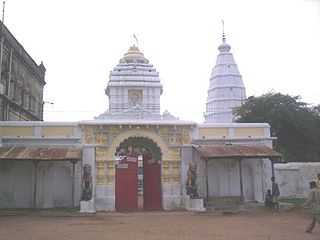Manikeswari

Brief History of Manikeswari
The deity of Chakrakotamandala comprising present days Kalahandi, Koraput and Bastar was Manikya debi or Manikeswari around 10th century A.D. Later on Kalahandi king Harichandra Deo struggled and died because of which his pregnant queen left for her father’s house in Gadapur, Phulbani. Some part of Phulbani was part of Mahakantara in ancient time and Chakrakota Mandala. Though capital of Chakrakotamandala is still being debated, it is clear that it has many similar with Kamala Mandala, another ancient name of Kalahandi, Manikya Devi came to Gadapur perhaps due to influence of Chakrakota Mandala. Later on, queen along with her son, Ramchandra Deo returned with Manikya Debi or Manikeswari as per Kalahandi’s public request that time. Manikeswari was brought from Gadapur (Phulbani) around 1200 A.D and it was located in Kalahandi. Manikeswari was also popularized by Suryabansi Gajapati in 15th -16th century in Puri region. Purushottam Dev Gajapati considered Manikeswari as consort of Lord Jagannath and made a shrine of Manikeswari at Chilika, now doesn’t exist. Manikeswari is royal family deity of Parlakhemundi. Manikeswari was installed in Bhawanipatna much later around 1849 AD during shifting of the capital from Junagarh. Some people also mention Manikeswari in Thumaul Rampur as Adipitha and Devi was brought to Bhawanipatna from there. Uditnarayan Deo laid the foundation of the present modern temple in Bhawanipatna and it was completed in 1947 by Brajamohan Deo. Manikeswari was associated with Kalahandi history as a goddess of wealth, Manik, since 10th century. There is some debate to relate Manikeswari with Stambeswari temple in Asurgarh-Narla around 5-6th century as well as Maningeeswari in Banapur in Puri. There are many Manikeswari worshiping locations in many place of Orissa and Chhattisgarh, especially in undivided districts of Koraput, Phulbani-Boudh, Bolangir-Sonepur, Ganjam-Gajapati, Angul-Dhenkanal, Keonjhar, Sundergarh, etc. due to influence by various rulers. Though Manikeswari has lots of historical significance in Orissa and Chhattisgarh, it is not yet fully come to lime light.
Manikeswari Temples
Bhawanipatna
Paralakhemundi
Thuamul Rampur
Jugasaipatna
Himgir, Sundargarh
Chhatar Jatra
This festival is celebrated during September–October, Durga Puja, in Bhawanipatna.